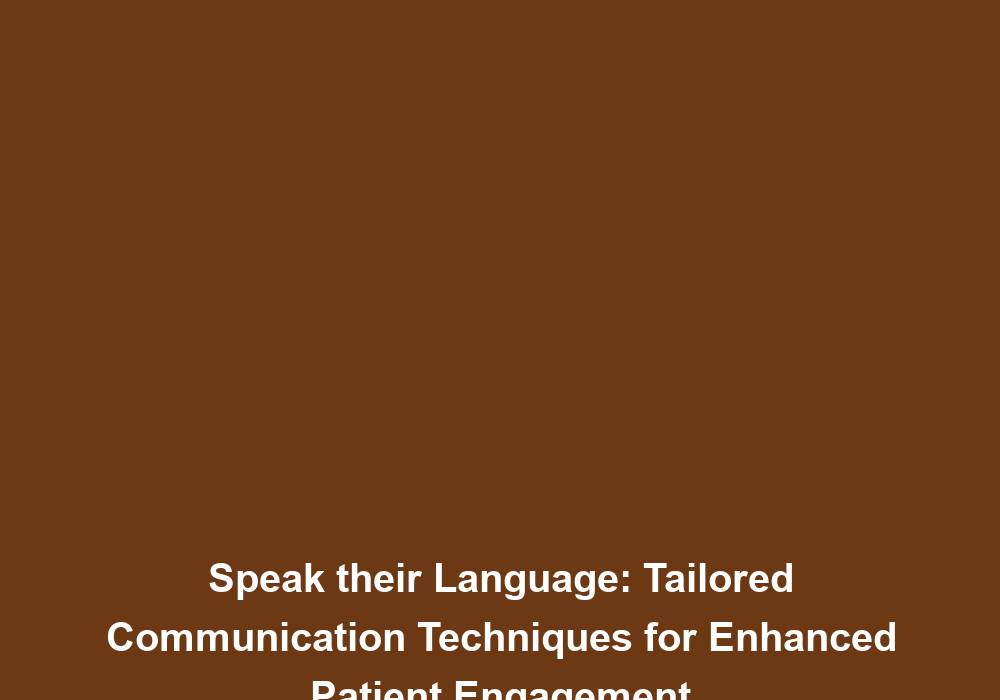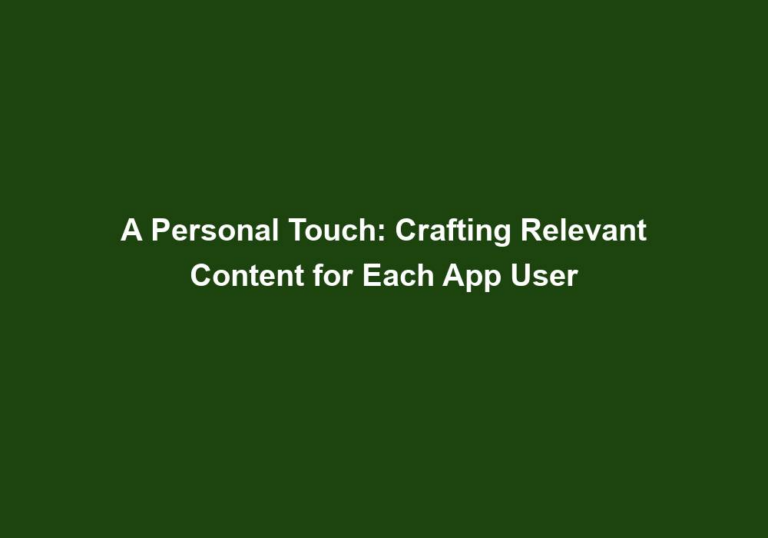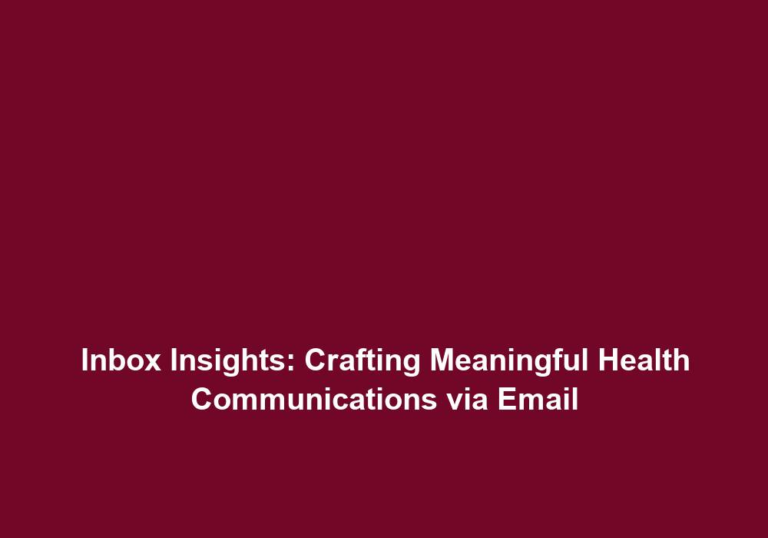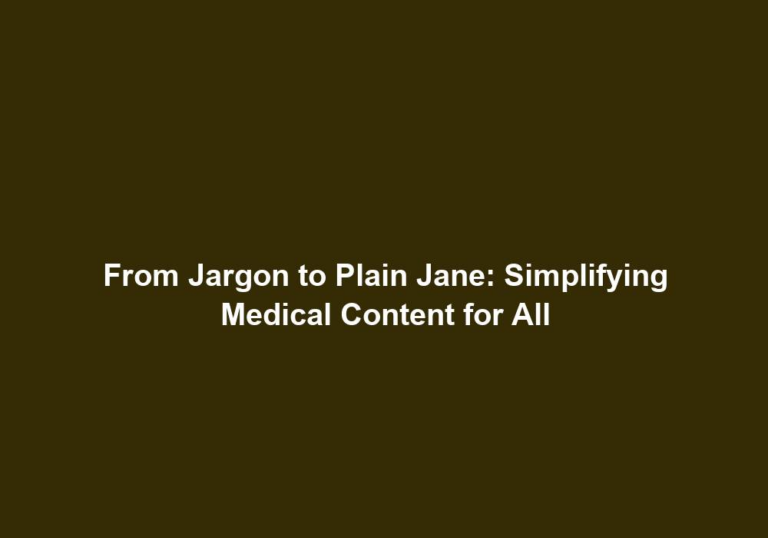Speak their Language: Tailored Communication Techniques for Enhanced Patient Engagement
Effective communication is crucial for providing quality healthcare services. When it comes to engaging patients and building strong doctor-patient relationships, it is essential to understand and tailor communication techniques to meet individual needs. By speaking the language of your patients, both figuratively and literally, you can significantly enhance patient engagement and improve health outcomes. In this article, we will explore various strategies and techniques to effectively communicate with patients, ensuring their active participation in their own healthcare journey.
1. The Importance of Tailoring Communication Techniques
Every patient is unique, with diverse backgrounds, cultural values, and preferences. To effectively engage patients, healthcare providers must adopt a patient-centric approach and tailor their communication techniques accordingly. By recognizing and adapting to individual differences, healthcare professionals can establish trust, foster collaboration, and empower patients to actively participate in their healthcare decisions.
Patient engagement is crucial as it leads to better health outcomes, increased patient satisfaction, and improved adherence to treatment plans. By tailoring communication techniques, healthcare providers can ensure that patients feel heard, understood, and involved in their care, leading to more positive healthcare experiences.
2. Language and Cultural Considerations
- Language Proficiency: Language barriers can hinder effective communication between healthcare providers and patients. To overcome this barrier, healthcare providers must ensure that they have access to interpreters or translators when patients are not proficient in the language spoken by the healthcare team. Clear and accurate communication is crucial for obtaining a comprehensive medical history, explaining diagnoses and treatment options, and addressing any concerns or questions.
Having access to language services, such as interpreters or translators, allows healthcare providers to effectively communicate with patients who have limited English proficiency. This ensures that patients fully understand their medical conditions, treatment plans, and any instructions provided by the healthcare team. Additionally, it helps to build trust and rapport between healthcare providers and patients, as they feel understood and valued.
- Cultural Sensitivity: Understanding and respecting cultural differences is vital for effective communication. Healthcare providers should educate themselves about the cultural norms, beliefs, and practices of their patients. This knowledge allows providers to communicate in a manner that is culturally sensitive and appropriate, promoting trust and reducing misunderstandings.
Cultural sensitivity plays a crucial role in patient engagement as it fosters a sense of inclusivity and respect. By understanding the cultural backgrounds of their patients, healthcare providers can tailor their communication style, tone, and content to align with patients’ cultural values and preferences. This helps to create a safe and trusting environment where patients feel comfortable expressing their concerns and actively participating in their healthcare decisions.
3. Active Listening and Empathy
- Active Listening: Active listening involves paying full attention to the patient, both verbally and non-verbally. It includes maintaining eye contact, nodding to show understanding, and avoiding distractions. By actively listening, providers can gain a deeper understanding of patients’ concerns, fears, and needs, facilitating a more personalized and patient-centered approach to care.
Active listening is a fundamental skill that healthcare providers should practice to enhance patient engagement. By actively listening, healthcare providers can gather meaningful information about patients’ symptoms, concerns, and expectations. This information can then be used to develop a tailored care plan that addresses the specific needs and preferences of each patient. Active listening also sends a message to patients that their opinions and experiences are valued, creating a collaborative and empowering healthcare environment.
- Empathy: Demonstrating empathy is crucial for establishing a strong rapport with patients. Empathetic communication involves understanding and validating patients’ emotions, showing compassion, and providing emotional support. By expressing empathy, healthcare providers can create a safe and supportive environment, enhancing patient trust and engagement.
Empathy plays a vital role in patient engagement as it helps healthcare providers to connect with patients on an emotional level. When patients feel understood and supported, they are more likely to actively engage in their healthcare journey and adhere to treatment plans. Healthcare providers can demonstrate empathy by actively listening, acknowledging patients’ emotions, and responding with compassion and understanding. This fosters a collaborative relationship built on trust and mutual respect.
4. Use of Plain Language
- Avoid Medical Jargon: Healthcare professionals often use complex medical terminology that may be difficult for patients to understand. To enhance patient engagement, it is essential to communicate in plain language, avoiding medical jargon whenever possible. Explain medical concepts, procedures, and treatment plans using simple and easily comprehensible terms. This empowers patients to actively participate in decision-making and take ownership of their healthcare.
Using plain language is crucial for effective communication in healthcare. When healthcare providers use medical jargon, patients may feel confused, overwhelmed, and disengaged from their own care. By using simple and clear language, healthcare providers can ensure that patients fully comprehend their medical conditions, treatment options, and any potential risks or benefits. This enables patients to make informed decisions about their healthcare and actively participate in their treatment plans.
- Visual Aids: Visual aids such as diagrams, charts, and models can significantly enhance patient understanding. Visual representations help simplify complex medical information and facilitate effective communication. Utilize visual aids to explain diagnoses, treatment options, and disease progression, making it easier for patients to grasp and retain information.
Visual aids are powerful tools that can enhance patient engagement and comprehension. By presenting information visually, healthcare providers can effectively convey complex medical concepts in a more accessible and digestible format. Visual aids can help patients visualize their medical conditions, understand treatment procedures, and track their progress. This visual reinforcement improves patient understanding, engagement, and adherence to treatment plans.
5. Tailoring Communication to Different Learning Styles
- Visual Learners: Visual learners comprehend information best through visual aids, such as diagrams or infographics. Use visual representations to supplement verbal explanations and provide patients with a visual understanding of their condition and treatment plans.
When communicating with visual learners, healthcare providers should utilize visual aids to enhance understanding and engagement. Visual learners rely on visual cues to process and retain information effectively. By incorporating diagrams, infographics, or other visual representations, healthcare providers can cater to the learning preferences of visual learners, promoting better comprehension and retention of medical information.
- Auditory Learners: Auditory learners absorb information best through verbal communication and discussion. Engage auditory learners by explaining medical concepts and treatment options verbally, allowing them to actively participate in the conversation and ask questions.
When communicating with auditory learners, healthcare providers should focus on verbal communication. Engaging in conversation, explaining medical concepts, and encouraging questions allows auditory learners to actively participate and process information effectively. Verbal communication provides auditory learners with the opportunity to ask clarifying questions and engage in dialogue, which enhances their understanding and involvement in their healthcare.
- Kinesthetic Learners: Kinesthetic learners learn best by doing or experiencing. Incorporate hands-on demonstrations, physical exercises, or interactive materials to engage kinesthetic learners in the learning process.
To effectively communicate with kinesthetic learners, healthcare providers should incorporate hands-on demonstrations or interactive materials. This allows kinesthetic learners to engage in experiential learning, which involves physical participation and manipulation. By involving kinesthetic learners in their own care, healthcare providers can promote better understanding and engagement, as kinesthetic learners thrive in tactile and interactive learning environments.
6. Effective Use of Technology
- Telemedicine: In today’s digital age, telemedicine has become an increasingly popular mode of healthcare delivery. Utilize telemedicine platforms to communicate with patients remotely, ensuring continuity of care and enhancing patient convenience and engagement.
Telemedicine offers a convenient and accessible way for healthcare providers to communicate with patients remotely. By leveraging telemedicine platforms, healthcare providers can engage patients in virtual visits, allowing for real-time communication and consultation. Telemedicine eliminates geographical barriers, making healthcare more accessible to patients who may have difficulty traveling to traditional healthcare facilities. This technology enables patients to actively participate in their healthcare from the comfort of their own homes, improving patient engagement and overall satisfaction.
- Patient Portals: Patient portals are online platforms that allow patients to access their medical records, test results, and communicate with healthcare providers. Encourage patients to utilize these portals to stay informed and engaged in their healthcare.
Patient portals provide patients with easy access to their medical information and enable secure communication with healthcare providers. By encouraging patients to utilize patient portals, healthcare providers can enhance patient engagement and empower patients to take an active role in managing their healthcare. Patient portals allow patients to view their medical records, access test results, request prescription refills, and communicate with their healthcare team, fostering a collaborative and patient-centered approach to care.
- Health Apps: There is a wide range of health apps available that provide educational resources, medication reminders, and tracking tools. Recommend relevant health apps to patients to empower them to actively manage their health.
Health apps offer patients convenient tools and resources to actively manage their health and engage in their healthcare. By recommending relevant health apps, healthcare providers can support patients in monitoring their health conditions, tracking symptoms, and managing medications. These apps provide educational resources, medication reminders, and personalized health insights, empowering patients to take control of their health and actively participate in their healthcare journey.
In conclusion, effective communication is crucial for enhancing patient engagement. By tailoring communication techniques to the individual needs of patients, healthcare providers can build trust, foster collaboration, and empower patients to actively participate in their healthcare journey. Understanding language and cultural considerations, active listening, using plain language, tailoring communication to different learning styles, and leveraging technology are all strategies that can significantly improve patient engagement and contribute to better health outcomes. Remember, speaking the language of your patients is not just about the words you use but also about truly understanding and addressing their unique needs and preferences.







